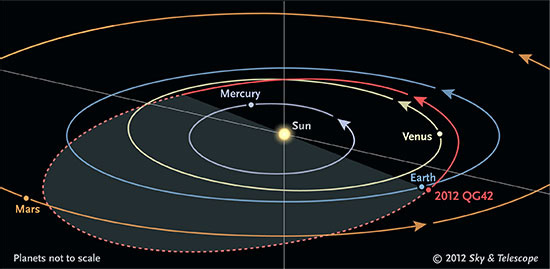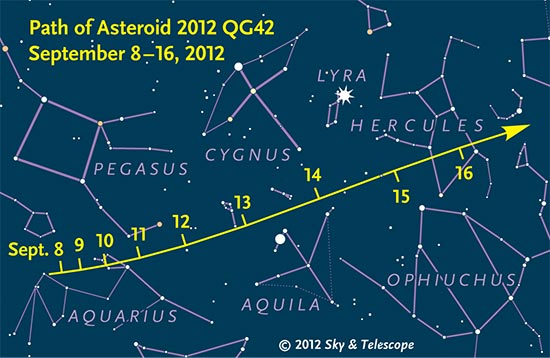A modest-sized near-Earth asteroid will pass 1,770,000 miles (2,860,000 km) from our planet on the night of Thursday–Friday, September 13–14. That’s a little more than seven times the Earth-Moon distance.
That's far enough to be completely harmless. However, 2012 QG42, estimated to be about 800 feet across, is classified as a PHA (potentially hazardous asteroid) because there's a small chance that it will hit Earth some time in the distant future. The Catalina Sky Survey in Arizona discovered the asteroid on August 26th, giving unusually long advance notice for a rock that’s so small in astronomical terms.
The asteroid is expected to shine at magnitude 14.5 at closest approach, making it a challenging object for backyard telescopes. But because of the orbital geometry, it will be brighter during the preceding week, peaking at magnitude 13.9 two or three nights before closest approach. That’s a little brighter than Pluto, so if your sky conditions are good, 2012 QG42 should be visible through Wednesday night using backyard telescopes with mirrors 10 inches or more in aperture.

Asteroid 2012 QG42 is on the opposite side of Earth from the Sun leading up to its closest approach. That makes it particularly bright because it's fully lit, and it also means it's ideally placed in the evening sky.
Asteroid 2012 QG42 is ideally placed for observing — well up in the late evening sky — from every inhabited place on Earth. The chart below shows its path through the constellations. The tick marks are for 0 hours Universal Time, which falls on the evening of the previous date for the time zones of the Americas.
Locating this asteroid won’t be easy; it requires excellent chart-reading skills and planetarium software capable of showing stars down to magnitude 14.5. You can download ephemerides (coordinates) for the asteroid from JPL Horizons. Make sure you type in “2012 QG42” in upper case, and select an observing location near you. The asteroid is close enough so that its position in the sky varies quite a lot depending on where you’re standing.

Tony Flanders
At closest approach the asteroid will be moving almost one arcsecond per clock second, so you should actually be able to watch it move across the field of view at high magnifications.
Don’t wait too long; the asteroid will fade rapidly after closest approach, reaching magnitude 15.2 just 24 hours later, making it an exceedingly challenging target.
If you don’t have a telescope, dark skies, or a clear night, there’s another option. The Virtual Telescope Project, a remote-controlled, 17-inch robotic telescope, will broadcast the asteroid’s closest approach live starting at 22:00 UT (6 p.m. EDT) on Wednesday, September 12th.
 4
4
Comments
Paul Cox
September 7, 2012 at 4:11 pm
Hi,
I put together an informational video about PHA 2012 QG42's pass - it's here: http://youtu.be/MXdBy5b8Mrw
Also a short time-lapse of it from last night here: http://goo.gl/1p9Sa
I'll continue to add updated observations of it in the lead-up to closest approach on the 13th/14th Sept. I'll also be providing continuous imaging of the asteroid throughout the night of the 13th/14th using the Slooh.com Half Metre telescope at their Canary Islands Observatory.
There will also be several free shows on Slooh's homepage during the night with a few special guests - including one of the Slooh members whose observations helped determine 2012 QG42's orbit.
You must be logged in to post a comment.
Chuck
September 7, 2012 at 4:44 pm
You have several references to NEA QG42 listed as QG24. Threw me through a loop when trying to look it up. I know read the whole article first, but...
You guys are great!
Thanks
Chuck the Grumpy One
You must be logged in to post a comment.
Durval Menezes
September 7, 2012 at 5:35 pm
Hello S&T folks,
The title of this article mentions "2012 QG24" while in the article per se it's cited as "2012 QG42" (note the inversion).
I've checked the MPC page [1] and was able to determine the correct designation is indeed "2012 QG42", as there's a QG24 but its complete designation is "2002 QG24".
Hope this helps.
Cheers,
--
Durval Menezes
[1] http://www.minorplanetcenter.net/iau/Ephemerides/Unusual/index.html
You must be logged in to post a comment.
Gail Kohler
September 10, 2012 at 10:21 am
I am way beyond an amateur! But I find all of this interesting and I am hooked. Learning very slowly. I bought a used telescope. It is 34 inches long and 5 1/2 inches wide, brand is Meade 4501. I am not able to use it at this time because the counter weight is off and I don't know how to put it on. Anyway my question is how do I find out what time the QG42 will be passing over my location? Anyone willing to help me is more than welcome to email me at [email protected]
I know giving out my email address in a public place is not a good idea but I am desperate! I am trying to teach myself how to enjoy all of this. I have my long. lat somewhere if need be but I live in Washington State in Rochester. I would be so very grateful for the info. Thank you very much!
You must be logged in to post a comment.
You must be logged in to post a comment.